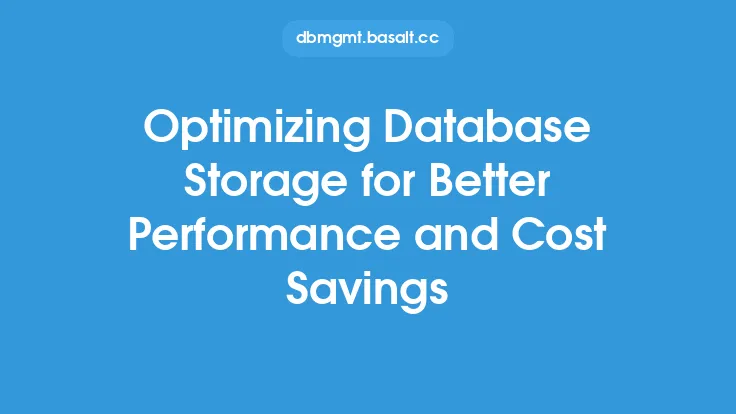When it comes to optimizing database configuration for query performance, there are several key factors to consider. A well-configured database can significantly improve the speed and efficiency of queries, leading to better overall system performance and user experience. In this article, we'll delve into the details of database configuration and explore the various techniques and strategies for optimizing query performance.
Understanding Database Configuration
Database configuration refers to the process of setting up and tuning a database management system (DBMS) to meet the specific needs of an application or organization. This includes configuring database parameters, such as buffer pool size, sort size, and lock timeout, as well as setting up database structures, such as indexes, views, and stored procedures. A good understanding of database configuration is essential for optimizing query performance, as it allows database administrators to identify and address potential bottlenecks and areas for improvement.
Identifying Performance Bottlenecks
To optimize database configuration for query performance, it's essential to identify performance bottlenecks. This can be done using various tools and techniques, such as query analysis, system monitoring, and benchmarking. Query analysis involves examining the execution plans of queries to identify areas where performance can be improved. System monitoring involves tracking system resources, such as CPU, memory, and disk usage, to identify potential bottlenecks. Benchmarking involves running a series of tests to measure the performance of the database under different loads and conditions.
Configuring Database Parameters
Database parameters play a critical role in optimizing query performance. These parameters control various aspects of database behavior, such as buffer pool size, sort size, and lock timeout. Configuring these parameters correctly can significantly improve query performance. For example, increasing the buffer pool size can improve query performance by reducing the number of disk I/O operations. Similarly, adjusting the sort size can improve query performance by reducing the amount of memory required for sorting.
Indexing and Partitioning
Indexing and partitioning are two powerful techniques for optimizing query performance. Indexing involves creating data structures that allow the database to quickly locate specific data. Partitioning involves dividing large tables into smaller, more manageable pieces. Both techniques can significantly improve query performance by reducing the amount of data that needs to be scanned. For example, creating an index on a frequently used column can improve query performance by allowing the database to quickly locate the required data.
Query Optimization Techniques
There are several query optimization techniques that can be used to improve query performance. These include rewriting queries to use more efficient algorithms, using query hints to guide the optimizer, and avoiding unnecessary joins and subqueries. Query rewriting involves modifying the query to use more efficient algorithms, such as using exists instead of in. Query hints involve providing additional information to the optimizer to help it choose the most efficient execution plan. Avoiding unnecessary joins and subqueries can improve query performance by reducing the amount of data that needs to be processed.
Storage Configuration
Storage configuration plays a critical role in optimizing query performance. This includes configuring disk storage, such as RAID levels and disk striping, as well as configuring storage devices, such as solid-state drives (SSDs) and hard disk drives (HDDs). Configuring disk storage correctly can improve query performance by reducing the time it takes to read and write data. For example, using RAID 10 can improve query performance by providing a high level of redundancy and fault tolerance.
Monitoring and Maintenance
Monitoring and maintenance are essential for optimizing database configuration for query performance. This includes monitoring system resources, such as CPU, memory, and disk usage, as well as monitoring query performance, such as execution time and resource usage. Regular maintenance tasks, such as updating statistics and rebuilding indexes, can also help to improve query performance. For example, updating statistics can help the optimizer choose the most efficient execution plan, while rebuilding indexes can improve query performance by reducing the time it takes to locate specific data.
Best Practices
There are several best practices that can be followed to optimize database configuration for query performance. These include following a structured approach to database configuration, using automated tools and scripts to simplify configuration tasks, and testing and validating configuration changes before implementing them in production. Following a structured approach to database configuration can help to ensure that all aspects of database configuration are considered, while using automated tools and scripts can help to simplify configuration tasks and reduce the risk of human error. Testing and validating configuration changes can help to ensure that changes do not introduce new performance issues or bugs.
Conclusion
Optimizing database configuration for query performance is a complex task that requires a deep understanding of database configuration and query optimization techniques. By following the techniques and strategies outlined in this article, database administrators can improve query performance, reduce latency, and improve overall system performance. Remember to always monitor and maintain the database configuration to ensure optimal performance and to make adjustments as needed to ensure the database continues to meet the evolving needs of the application or organization.





